The German Reichsarbeitsdienst (Reich Labor Service)
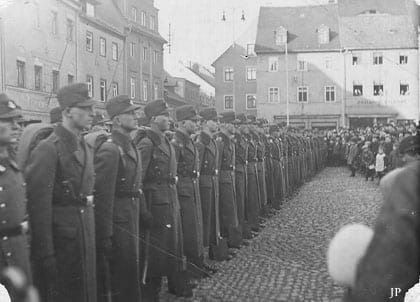
On June 5th, 1931 – two years before the NSDAP came to power – German Chancellor Brüning gave the authorization to create a national work service called the Freiwilliger Arbeitsdienst, or FAD- the Voluntary Labor Service. Konstantin Hierl was appointed as the head of this new national organization. Soon after its formation, Hierl began to absorb the many independent camps that had been formed earlier in a process of centralizing state control over the area of national labor work. Interestingly, Hierl was also a high-ranking member of the NSDAP at the time, being in charge of what was known as Organization Department II of the party. In August of 1933, after the NSDAP came to power, the Freiwilliger Abreitdienst was renamed as the Nationalsozialist-Arbeitdienst, or NSAD – the National Socialist Labor Service. Hierl continued in his command of the newly-named NSAD and would go on to control it until the very end of WWII. In fact, when the National Socialists came to power, Hitler appointed Hierl as the State Secretary for Labor Service and a member of the Reich Labor Ministry. He would go on to become the Reich Labor Leader in 1935, a Reichsleiter in 1936, and a Reichsminister in 1943. He survived WWII, was tried and found guilty of “major offenses” after the war, and spent five years in a labor camp. He was released soon after and died in 1955. 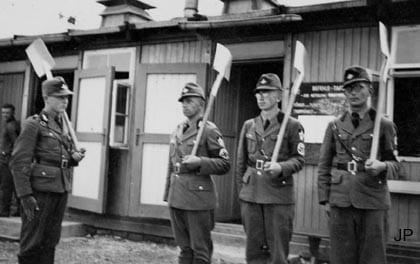 On July 11th, 1934 the NSAD was renamed a final time, this time as the Reichsarbeitsdienst, or RAD – the State Labor Service. The RAD was initially a party organization like the NSAD before it, but on June 26th, 1935, the Reichs Labor Service Law was passed in which service in the Reichsarbeitsdienst for 6 months’ time was made compulsory and nation-wide. The RAD was no longer a party organization and was made a Supreme Reich Authority and full-fledged state organization equal to the other Reich ministries. Previous to the Reich Labor Service Law, a law was passed in which military service was also made compulsory. Together, the two laws created a centralized, national, and compulsory system in which all males between the ages 18 and 25 would first enter labor service for a period of 6 months, and upon completion, enter service for two years in one of the branches of the Wehrmacht – the German Armed Forces. Contrary to common assumption though, the RAD was not, in fact, a part of the German Armed Forces, but as stated earlier, an independent state organization. The confusion regarding the RAD resulted largely from a move in 1938 in which the Reichsarbeitsdienst and the Organization Todt (another labor organization)were directed to support the Wehrmacht in various auxiliary tasks – a task they would perform throughout WWII. In fact, the Reichsarbeitsdienst was actually known as a Wehrmachtsgefolge, or armed forces auxiliary. What this meant was that the RAD was deemed an important auxiliary organization to the smooth operations of the regular armed forces. Although later in WWII they were even allowed to carry weapons, they were never actually a part of the official armed forces, a status reserved exclusively for the Heer, Luftwaffe, and Kriegsmarine, and tactically, the Waffen-SS.  At the same time that the RAD was officially established in July 1934, it was also divided into separate sections for males and for females. The Reichsarbeitsdienst Manner, or RAD/M, was set up for men, and the Reichsarbeitsdienst der weibliche Jugend, or RAD/wJ, for females. The RAD/M was organized into Arbeitsgau or Divisional Districts, each being numbered with a Roman numeral between I and XXXX (1 and 40). An Arbeitsgau was headed by a German officer with a staff, HQ, and a Wachabteilung (Guard Company)numbered according to the Arbeitsgau it was located in. Around 8 battalion-sized units are known as Arbeitsgruppen consisting of 1,200 to 1,800 men each were also grouped under each Arbeitsgau. Several Arbeitsgruppen could be grouped together with a regimental-sized unit known as a Bereich, while an Arbeitsgruppe itself consisted of six company-sized formations known as Abteilungen. The company-sized RAD Abteilung – not to be confused with the unit of the same name in the Wehrmacht which was a battalion-sized unit – was the core group around which the functions of the Reichsarbeitsdienst revolved. The pre-war RAD Abteilung was based at a specific camp location from which its members would train, drill, practice, and take part in the various labor projects their unit was assigned to. Each camp and its Abteilung was given a number designation listed along with its higher Arbeitsgruppen number. These two numbers were often displayed together on the ubiquitous RAD Dienststellenabzeichen -an arm badge in the shape of a downward pointing shovel blade worn on the upper left shoulder of all uniforms and greatcoats worn by all personnel. A RAD Abteilungen consisted of 214 men grouped together in a six-man staff and four platoon-sized units called Züge, each of 69 men. Each Zügewas, in turn, made up of three 17-man section-sized units known as Trupps. The “front-line” rank and file members who made up the bulk of the RAD workforce was armed with spades and transported by bicycles. Before WWII began in 1939, the RAD took part in labor projects such as the reclamation of marshland for cultivation, the construction of dikes, drainage improvement work, vast tree removal operations, the reclamation of fallow or wasted land, and the construction of roads. In a role, the RAD would come to know well, it supported the Wehrmacht during the occupation of Austria in March 1938, the occupation of the Sudetenland in October 1938, and the occupation of Czechoslovakia in March 1939. During the summer of 1938, until the war began, 300 RAD units aided in the construction of the Westwall fortification line along the western German border, while in the east, another 100 RAD units aided in the construction of the Ostwall fortification line along the eastern German border. As the war drew nearer, in August of 1939,115 RAD units served in East Prussia helping with harvest work, and other RAD units served in Danzig. 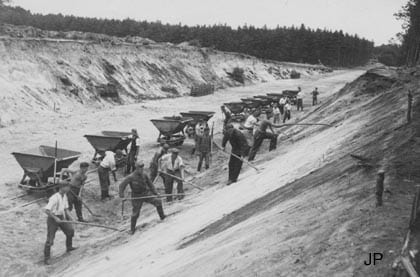 General mobilization was declared in Germany on August 26th, 1939, and to aid the call to arms, 1,050 individual Reichsarbeitsdienst units were transferred in full to the Wehrmacht, specifically to the Heer, to form the basis of the new Bautruppen – the construction troops that would build roads, clear obstacles, dig trenches, create fortification, and take part in all manner of military construction duties. The 1,050 RAD Abteilungen were transferred directly to the Wehrmacht Heer and expanded to 401 men each through the addition of older untrained army reservists. They were formed into a series of 55 regimental-sized units known as Abschnittsbaustäbe which were numbered in the 1 to 111 series. Each Abschnittsbaustäbe consisted of four 2,000-man Bau-Bataillone in the1 to 335 number series. Each of these was, in turn, made up of four of the ex-RAD Abteilungen, now expanded to 401 men each. 18 Heavy and 12 Light Motorized Road Construction Battalions were also formed at this time from the RAD units transferred to the Wehrmacht. About 60% of the newly formed Bautruppen units spent the majority of their time during the Polish Campaign clearing roads so that supplies and men could continue to reach the front. After the Campaign in Poland had ended, the Wehrmacht kept the Bautruppen units that had been formed from the RAD and in their place was formed a new contingent of 900 RAD Abteilungen that would once again take up the previous duties of the Reichsarbeitsdienst. 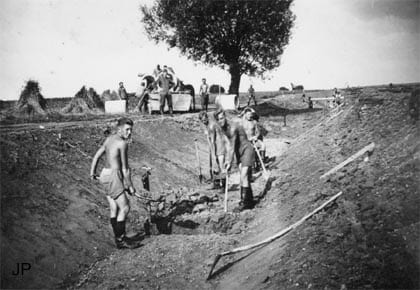 Throughout WWII the RAD continued to serve its originally established duty of training young men prior to their service in the Wehrmacht by providing construction and agricultural work for the nation. But also throughout WWII, the RAD increasingly took part in more militarized roles. During the Norwegian Campaign and the Campaign in the West in 1940, hundreds of RAD units took part in supporting the troops by helping to ensure that supplies continued to reach the front over clear roadways. They also helped repair damaged roads, built and repaired airstrips, constructed coastal fortifications, loaded and unloaded supplies and ammunition, laid minefields, manned fortifications, and even helped guard vital locations and prisoners. RAD units served on all fronts during WWII, from Norway to the Mediterranean Sea, and from France in the west, to the far reaches of Russia in the east. Units served in Albania, Greece, and the former Yugoslavia. In the Soviet Union, they supported the Wehrmacht in its massive drives towards Moscow in 1941, and into the Caucasus Region in 1942. Many RAD units were encircled and forced into front-line combat, while other units were drafted directly into military service on the spot. In 1942, there were at least 427 RAD units serving on the Eastern Front. Increasingly in the fighting on the Eastern Front, RAD units took up arms to fight off Soviet tanks as well as partisan forces. Security operations also became an increasingly common duty of the RAD units. 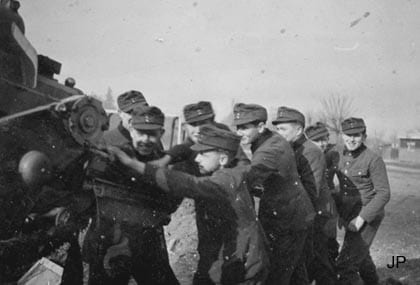 Service was not limited to the multitude of combat support roles listed above though, as hundreds of RAD units were trained and later used as anti-aircraft units under the control of the Luftwaffe. Many saw service along the Western Front in the form of RAD Flak Batteries, while others also saw service in the East as ground combat units against the advancing Soviet Armies. In October of 1944, at least 60,000 RAD troops are known to have served in RAD Flak Batteries. When serving in RAD Flak Batteries, the troops were known as Luftwaffe-Flakhelfer. RAD troops were but a small fraction of the hundreds of thousands that served in such a role during WWII. As WWII reached its end, in February of 1945, service in the RAD was reduced to between 6 and 8 weeks time, while training was limited exclusively to infantry and anti-tank tactics. Although Hierl had avoided a move to join the RAD with the German Volksturm – the “Peoples Army” formed as a last-ditch defense of the homeland – thus maintaining the independence of the RAD till the very end of WWII, the RAD could not avoid conscription into the front-lines as the war neared its conclusion.6 major front-line units consisting of Reichsarbeitsdienst troops were formed in the last months of WWII, 3 of which are known to have seen limited but fierce action. The 6 units of mainly RAD troops known to have been formed were as follows: RAD-Division z.b.V.1/Infanterie-Division Albert Leo Schlageter, RAD-Division z.b.V.2/Infanterie-Division Friedrich Ludwig Jahn, RAD-Division z.b.V.3/Infanterie-Division Theodor Körner, RAD-Division z.b.V.4/Infanterie-Division Güstrow, Gebirgsjager-Brigade Steiermark, and Gebrigsjager-Brigade Enns. The Reichsarbeitsdienst was disbanded with the collapse of the Third Reich on May 8th, 1945. Reichsarbeitsdienst Uniforms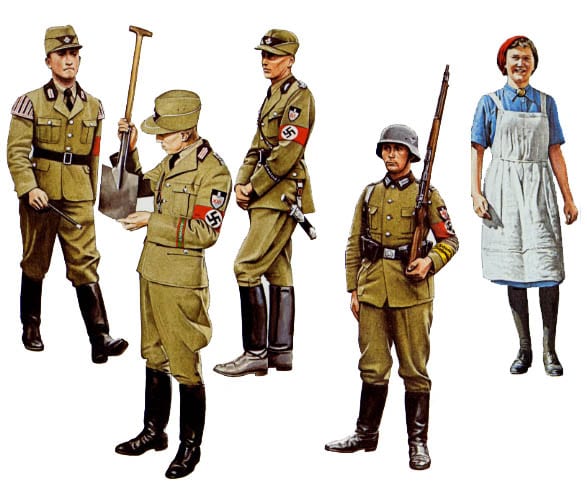 These examples are a sampling of the many variations and styles of uniforms worn by members of the RAD both before and during WWII. They are shown to give an impression of the central uniform worn by the RAD. Illustrations copyright Pierre Turner. Reichsarbeitsdienst Ranks
Reichsarbeitsdienst Units
|

 The German Reichsarbeitsdienst (RAD), or German Reich Labor Service, was formed in July of 1934 as the official state and party labor service. The RAD was not unique though, as various labor organizations had existed in Germany for many years prior to 1934. During the later 1920’s – a time of great economic hardship in Germany – many political, church, and civic groups organized independent work camps to help provide some form of employment for the many ex-servicemen and the huge numbers of unemployed workers. The work camps were used to supply labor for various civic and agricultural construction duties throughout Germany, and to generally help relieve the strain of high unemployment. Even the fledgling NSDAP formed a number of these sorts of camps.
The German Reichsarbeitsdienst (RAD), or German Reich Labor Service, was formed in July of 1934 as the official state and party labor service. The RAD was not unique though, as various labor organizations had existed in Germany for many years prior to 1934. During the later 1920’s – a time of great economic hardship in Germany – many political, church, and civic groups organized independent work camps to help provide some form of employment for the many ex-servicemen and the huge numbers of unemployed workers. The work camps were used to supply labor for various civic and agricultural construction duties throughout Germany, and to generally help relieve the strain of high unemployment. Even the fledgling NSDAP formed a number of these sorts of camps.